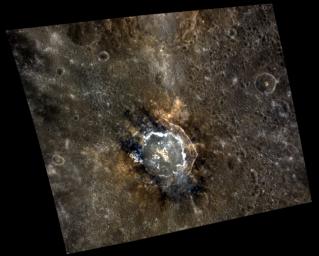This complex crater was recently named to honor Theodor Seuss Geisel, better known as Dr. Seuss. Seuss crater is relatively fresh, its floor contains impact melt and hollows, and the impact has excavated materials with different color characteristics. These characteristics make the crater very interesting, slightly odd, and colorful in appearance, much like Seuss's illustrations.
This image was acquired as a high-resolution targeted color observation. Targeted color observations are images of a small area on Mercury's surface at resolutions higher than the 1-kilometer/pixel 8-color base map. During MESSENGER's one-year primary mission, hundreds of targeted color observations were obtained. During MESSENGER's extended mission, high-resolution targeted color observations are more rare, as the 3-color base map is covering Mercury's northern hemisphere with the highest-resolution color images that are possible.
Date acquired: August 18, 2011
Image Mission Elapsed Time (MET): 222190048, 222190044, 222190040
Image ID: 648749, 648748, 648747
Instrument: Wide Angle Camera (WAC) of the Mercury Dual Imaging System (MDIS)
WAC filters: 9, 7, 6 (996, 748, 433 nanometers) in red, green, and blue
Center Latitude: 8.40°
Center Longitude: 33.66° E
Resolution: 211 meters/pixel
Scale: Seuss crater is approximately 67 km (42 mi.) in diameter.
Incidence Angle: 17.3°
Emission Angle: 34.6°
Phase Angle: 50.3°
The MESSENGER spacecraft is the first ever to orbit the planet Mercury, and the spacecraft's seven scientific instruments and radio science investigation are unraveling the history and evolution of the Solar System's innermost planet. Visit the Why Mercury? section of this website to learn more about the key science questions that the MESSENGER mission is addressing. During the one-year primary mission, MDIS acquired 88,746 images and extensive other data sets. MESSENGER is now in a year-long extended mission, during which plans call for the acquisition of more than 80,000 additional images to support MESSENGER's science goals.
These images are from MESSENGER, a NASA Discovery mission to conduct the first orbital study of the innermost planet, Mercury. For information regarding the use of images, see the MESSENGER image use policy.

 Planetary Data System
Planetary Data System












